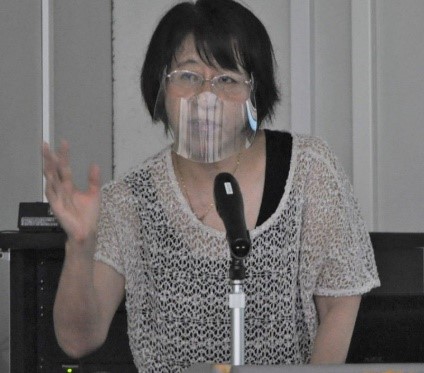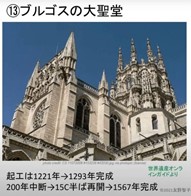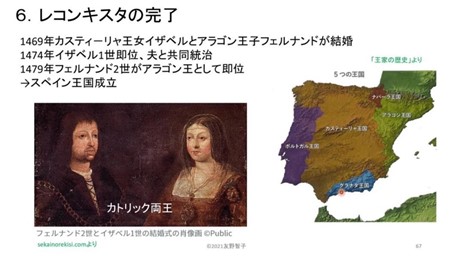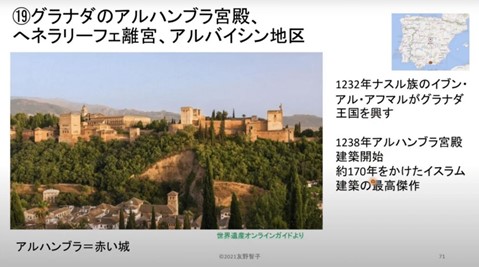The Fist 2021 Cross-cultural Awareness Workshop
The History and World Heritages in Kingdom of Spain during The Age of Reconquista
Speaker: Ms. TOMONO Satoko, World Heritage Academy Certified Instructor
Date: July 10, 2021
Venue: Minato City Life Long Learning Center Room 305
Co-host: Minato City Board of Education
Sponsor: World Heritage Academy

Reconquista is the movement undertaken by Catholics for the purpose of recovering their homeland. In other words, to recapture Iberian Peninsula from Muslims. Spanish Flag is called as the flag of blood and gold. Its yellow part represents the abundant land, red part the symbol of blood shed at the repel of foreign enemies, and the crest located in the center of the flag was the one used by five countries existed earlier in Iberian Peninsula. Those five countries were the Kingdom of Castile, Kingdom of Leon, Kingdom of Aragon, Kingdom of Navarre, and Emirate of Granada. Spain has 48 World Heritages, the third largest in the world; 19 out of 48 are closely related with the age of Reconquista.
1.Pre-Reconquista
Iberian Peninsula before Reconquista was a part of Roman Empire. When the migration of Germanic peoples began, Vandal was the first migrated into Iberian Peninsula and still remains as Andalusia even now. Then, Visigoth migrated crossing Pyrenes in 508 and moved the capital to Toledo. Visigoth converted to Catholic in the end of 6th century.
Muhammad started Islam in 622. Umayyad Caliphate, a clan of Caliph the successor of Muhammad, expanded its land as Hereditary dynasty and advanced into Iberian Peninsula. Catholics escaped to the north and Visigothic Kingdom was overthrown in 711.
2.Battles with Umayyad Caliphate and Caliphate of Cordova
While being oppressed by Umayyad Caliphate, Kingdom of Asturias was founded around the capitol Oviedo and won the Battle of Covadonga in 722 which marked the start of Reconquista. After the extinction of Umayyad Caliphate in 750, Abd al-Rahman I who escaped from Arabian Peninsula established Caliphate of Cordova around the capitol of Cordova in 756 and faced off against Frank Kingdom. Frank Kingdom placed the Margrave of Spain to block the invasion of Islamic militants rushing over Pyrenes. The Margrave of Spain as well as Kingdom of Asturias became the driving force of Reconquista.
Allied forces made up by Kingdom of Leon separated from Kingdom of Asturias, Kingdom of Castile separated from Kingdom of Leon, and Kingdom of Navarre separated from Margrave of Spain defeated Islamic militants at the Battle of Simancas in 939 but was immediately struck back by them. Caliphate of Cordova reached the peak of influence under the reign of Abd al-Rahman III and the capitol Cordova prospered a lot. Al-Mansur of Caliphate of Cordova repeatedly made expeditions and plunders into bases of Catholic countries, thereby Kingdoms of Leon, Navarre and Castile were ruined. Santiago de Compostela also was destroyed around the same time.
World Heritages associated with this age
Religious structures in the Kingdom of Asturias and Oviedo which are built in Pre-Romanesque style; Palmeral of Elche where a lot of palms were produced thanks to the superior irrigation technology; Caliph City in Medina Alarza which was the imperial villa of Abd al-Rahman III
3.Taifa Kingdoms and Confrontation with Almoravid Dynasty
After the ruin of Caliphate of Cordova in 1031, the Kingdom was divided into Islamic Taifa Kingdoms. Kingdom of Navarre, Christian part of the Kingdom, was divided into Kingdom of Navarre, Kingdom of Castile and Kingdom of Aragon. Kingdom of Castile which merged Kingdom of Leon into it recaptured Toledo in 1085 where Jews, Muslims and Christians coexisted and prospered as the capitol of Kingdom of Castile. Phillip II moved the capitol to Madrid later in 1561.
Almoravid Dynasty of Morocco, Muslim part of the Kingdom, in the meantime, landed on Iberian Peninsula and dominated Andalusia. Kingdom of Aragon conquered Zaragoza in 1118 and expand its power and confronted with Kingdom of Castile. Almoravid Dynasty was destroyed by Almohad Caliphate in 1147.
World Heritages associated with this age
Santiago de Compostela which originally was built as the tomb of St. James and was rebuilt in Romanesque Style in 1128; Pilgrimage Route of Santiago de Compostela; Roads of Camino Frances and the northern part of Spain which runs from Oviedo to Pamplona and Burgos; Historic City of Toledo where the Gothic Cathedral that carries El Greco’s paintings exists; Old town of Alvila and a group of churches outside of defensive wall
4.Confrontation with Almohad Caliphate
Andalusia prospered under the reign by Almohad Caliphate. Ancient Greek civilization was conveyed from the Subcenter Seville to Europe through Islam, and the study on Aristotle conducted by Judge Ibn Rushd affected the Scholastic philosophy quite a lot.
As the result of the division of Christian countries, the relationship between Islamic power and Christian power was kept even in Spain. With the emergence of Pope Innocent III in Rome, confrontation with Islamic power became much clearer as seen in the dispatch of the fourth Crusaders. Then, allied forces of Christian powers were created in Iberian Peninsula which won the Battle of Las Navas de Tolosa in 1212 that marked the opening of the age of Reconquista.
Kingdom of Castile which merged Kingdom of Leon occupied Cordova in 1236, surrendered Seville in 1248 and reached the Strait of Gibraltar in 1251. Aragon conquered Valencia in 1238. On the part of Islamic power, Almohad Caliphate was destroyed in 1276. Nasr Dynasty expanded its controlling power in Granada.
World Heritages associated with this age:


Photo captions:
(Left) Old City of Saramanca; Symbol of the city “Those who want to acquire knowledge need to go to Saramanca”
(Right) Burgos Cathedral; Construction began in 1221 and completed in 1567. After a hiatus of nearly 200 years, work resumed on the Burgos Cathedral towards the middle of the 15th century and continued for more than 100 years.
Historic Walled Town of Cuenca which is the first Gothic style building in Spain; Old City of Saramanca where Columbus studied and is widely known by a saying that goes “those who want to acquire knowledge need to go to Saramanca”; Burgos Cathedral which is the most superior Gothic building in Spain; Historical District of Cordova represented by Mezquita; Cathedral of Seville where the tomb of Columbus exists, and Alcazar which was built in Mudejar style
Castile, Aragon and Granada after Reconquista
After the reign of Fernando III who undertook Reconquista, Kingdom of Castile led by Kings brother Fernando overturned Antequera the central city of Emirate of Granada in 1410 in spite of decrease in population due to civil war or black plaque pandemic.
Kingdom of Aragon after Jaime I who undertook Reconquista expanded its royal power to Mediterranean Sea, and, then, Alfonso V conquered Kingdom of Naples of Italy in 1443.
On the other hand, Emirate of Granada a Nasr Dynasty survived through skillful diplomacy as well as trade.
World Heritages associated with this age
Royal Monastery of Santa Maria de Guadalupe where black wooden holy mother dug out at a river side by an oracle is stored; Cultural Landscape of the Serra de Tramuntana where you can see water irrigation system built by Arab; Mudejar style architecture in Aragon
6.Completion of Reconquista
Princess Isabel of Castile and Prince Fernando of Aragon were married in 1469. Each of them later took the throne and Kingdom of Spain was borne. Muhammad Ⅻ of Granada surrendered in 1492. With the bloodless fall of Alhambra, Reconquista was completed and Spain entered the Age of Discovery. The growing threat by Ottoman Empire which surrendered Byzantine Empire in 1453 and expanded its power from its capitol Constantinople lied behind the surrender of Granada as well as the sweeping of Islamic power out of Iberian Peninsula.

(Photo captions):
(Left) Portrait of Fernando I and Isabel I at their marriage
(Right) Five kingdoms; Kingdom of Castile, Kingdom of Leon, Kingdom of Aragon, Kingdom ofNavarre, and Emirate of Granada
World Heritages associated with this age
The Alhambra, the best masterpiece of Islamic architecture which took 170 years for completion. Once I saw it, I was very much interested in the world heritages.

Photo captions:
Alhambra, Generalife and Albyzin, Granada
(Left) Alhambra, the red castle
(Right)
・Ibn Nasr of Nazari founded Emiratre of Granada in 1232
・Construction of Alhambra began in 1238
・The best masterpiece of Islamic architecture that took 170 years for completion
(Written by YAMADA Yuko, the International Science & Culture Committee, and translated by SUDA Yasushi, the PR & Internet Committee Associate)
